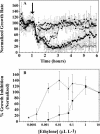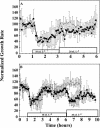Short-term growth responses to ethylene in Arabidopsis seedlings are EIN3/EIL1 independent
- PMID: 15466219
- PMCID: PMC523354
- DOI: 10.1104/pp.104.050393
Short-term growth responses to ethylene in Arabidopsis seedlings are EIN3/EIL1 independent
Abstract
Kinetic studies indicate there are two phases to growth inhibition by ethylene for the hypocotyls of etiolated Arabidopsis seedlings. Phase I is transient, while phase II results in sustained growth inhibition. The EIN2 membrane protein is required for both the first and second phases of growth inhibition by ethylene, while the transcription factors EIN3 and EIL1 are required for the second phase but not the first phase. The first phase lasts no more than 2 h. It is less sensitive to the ethylene response inhibitor 1-methylcyclopropene and more sensitive to ethylene than the second phase. The first phase shows adaptation at low concentrations of ethylene (< or =0.01 microL L(-1)) with a relative refractory period of 5 h after ethylene is added. A modified signal transduction model is proposed that accounts for the two phases of growth inhibition.
Figures





References
-
- Abeles FB, Morgan PW, Saltveit ME Jr (1992) Ethylene in Plant Biology, Ed 2. Academic Press, San Diego
-
- Alonso JM, Hirayama T, Roman G, Nourizadeh S, Ecker JR (1999) EIN2, a bifunctional transducer of ethylene and stress responses in Arabidopsis. Science 284: 2148–2152 - PubMed
Publication types
MeSH terms
Substances
LinkOut - more resources
Full Text Sources
Other Literature Sources
Molecular Biology Databases

